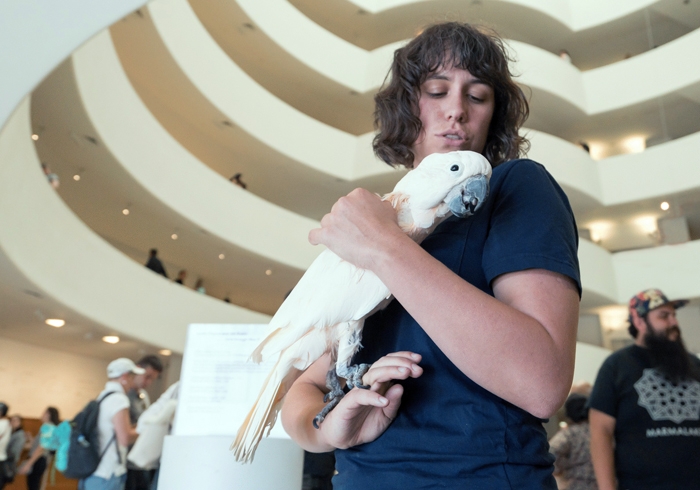Solomon R. Guggenheim Museum and other venues, New York, 1 March – 31 August
At St Philip’s church, the second oldest Black Episcopal parish in the US, Reverend Chloe Breyer referred to it as “the Guggenheim project”. ‘It’ is …circle through New York, a project by Lenka Clayton and Jon Rubin that, in addition to this Harlem church, is sited at Jus Broadcasting in Long Island City, the Institute for the Study of the Ancient World on the Upper East Side, Pet Resources in the South Bronx, the Frank Sinatra School of the Arts in Astoria and the Solomon R. Guggenheim Museum itself. Clayton and Rubin have brought these organisations together in a rotating, six-point call-and-response, wherein contributions from each location are installed or reinterpreted by one of the other locations on a monthly basis. That the project was commissioned by the Guggenheim’s flagship Social Practice programme shakes up a clear understanding of authorship; that it also began from the premise of drawing a circle on a map around the museum’s location on the Upper East Side, and cherry-picking participants from along its edge, is another problematic act. While goodwill buttresses the artists’ and institution’s intentions, if you throw a stone anywhere in any of the five boroughs of New York, it’ll hit something damned interesting.
The project’s full title includes each organisation’s contribution to the project: A talking parrot, a high school drama class, a Punjabi TV show, the oldest song in the world, a museum artwork, and a congregation’s call to action circle through New York. In the weeks I traversed the circle, the ‘museum artwork’ – Felix Gonzalez-Torres’s Untitled (Public Opinion) (1991), black-rod liquorice candies installed flat on the floor and running the length of the wall – was presented at Jus Broadcasting, where it was used as the prompt for some of their in-house television programming. (I, along with people solicited from the street, responded to the Gonzalez-Torres work on Jus Broadcasting’s regular programme Honestly). I witnessed Pinkie, the ‘talking parrot’, demure from so much public attention in the rotunda of the Guggenheim, and listened to her explore the church’s acoustics as part of the congregation during a service at St Philip’s. I was told to leave the Frank Sinatra School of the Arts, down the street from Jus, when I asked a security guard about the ‘oldest song in the world’ – apparently they’re just lyrics, and each participating organisation may interpret them as they wish. Apparently, I missed the students’ performance a few weeks before.
…circle through New York’s virtue is messiness: too unwieldy, and contingent on too many voices
I didn’t see everything, and people aren’t really expected to. …circle through New York’s virtue is messiness: too unwieldy, and contingent on too many voices, it powerfully resists critical resolution, and hopefully embraces intimacy, between participants or audience members, as the metric for understanding. It would seem that though Clayton and Rubin authored the project, and the Guggenheim presented it, the entire thing belongs to those people involved, and their experience thereof. But the project doesn’t stop there, and indeed, the press release, the website, the blog and Instagram, and their insistence on behind-the-scenes processes, overplay the idea of accessibility and supplant it with the individual responsibility involved with democratic forms of artmaking. Additionally, artists submit this type of grassroots artmaking to a large institution precisely for its ability to authorise it, and impose a narrative – it’s the Guggenheim project, after all.
At the church service I attended, members of the congregation excitedly considered Pinkie’s role within the service, and the bird became a foil to better understand the care with which they undertook their ceremony, and community. It reinforces the mission of St Philip’s contribution, a ‘call to action’. It reads, in part: ‘We fervently ask that all who hear our story take action against these injustices, including self-examination of your own participation in discrimination and injustice. Always be just as ready to listen as you are emboldened to speak out for or against others.’
